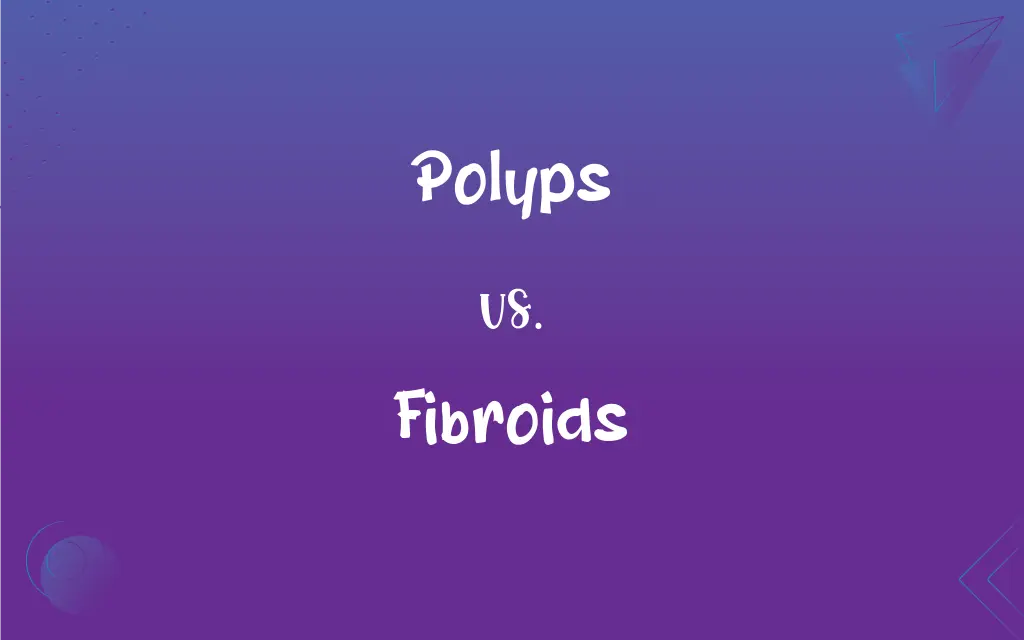Polyps vs. Fibroids: What's the Difference?
Edited by Janet White || By Harlon Moss || Updated on October 29, 2023
Polyps are benign growths on mucous membranes; fibroids are benign muscle tumors in the uterus.

Key Differences
Polyps are growths that develop on the inner surface of various organs, often on a mucous membrane, whereas fibroids are non-cancerous tumors that grow in the muscle tissue of the uterus.
Polyps can be found in various locations, such as the colon, nose, or uterus. In contrast, fibroids are specific to the uterus in women.
Polyps, depending on their location, can cause symptoms like bleeding or nasal obstruction, while fibroids can lead to heavy menstrual bleeding, pain, and reproductive issues.
The cause of polyps varies based on type and location, but they often result from abnormal tissue growth. Fibroids, on the other hand, arise from the smooth muscular tissue of the uterus and their exact cause remains unclear.
While both polyps and fibroids are generally benign, meaning non-cancerous, they can cause complications and might need medical intervention based on severity and symptoms.
ADVERTISEMENT
Comparison Chart
Nature
Benign growths on mucous membranes
Benign muscle tumors
Location
Various organs like colon, nose, or uterus
Uterus only
Typical Symptoms
Bleeding, nasal obstruction depending on location
Heavy menstrual bleeding, pain
Causes
Abnormal tissue growth
Unclear, arises from muscular tissue of the uterus
Potential Complications
Can become cancerous in some cases
Reproductive issues, pain, anemia
ADVERTISEMENT
Polyps and Fibroids Definitions
Polyps
Overgrowths often detected in the colon.
Regular screenings can detect polyps early.
Fibroids
Non-cancerous growths in the uterine muscle.
Fibroids can sometimes interfere with fertility.
Polyps
Non-cancerous protrusions on inner surfaces of organs.
The endoscopy revealed several polyps in his stomach.
Fibroids
Uterine masses that can range in size.
Fibroids were the reason behind her pelvic pain.
Polyps
Benign growths on mucous membranes.
The doctor found polyps during her colonoscopy.
Fibroids
Smooth muscle tumors often found in the uterus.
The ultrasound detected multiple fibroids.
Polyps
Small, abnormal tissue growths.
She had nasal polyps causing her breathing difficulties.
Fibroids
Benign tumors in the uterus.
Her heavy periods were attributed to fibroids.
Polyps
Growths that can vary in size and shape.
The uterine polyps were discovered during her routine checkup.
Fibroids
Growths causing menstrual irregularities in some women.
Her doctor recommended surgery to remove the large fibroids.
Polyps
A body form of a cnidarian, such as a hydra or coral, that is cylindrical in shape, has a mouth usually surrounded by tentacles at one end, and is often attached to something at the other end.
Fibroids
Composed of or resembling fibrous tissue.
Fibroids
A fibroma or myoma occurring especially in the uterine wall.
Fibroids
Plural of fibroid
FAQs
Are fibroids found outside the uterus?
No, fibroids are specific to the uterus.
What are polyps?
Polyps are benign growths that develop on mucous membranes in various organs.
What are fibroids?
Fibroids are benign muscle tumors found in the uterus.
How are fibroids diagnosed?
Often through pelvic exams, ultrasounds, or other imaging.
Where can polyps develop?
Polyps can develop in the colon, nose, uterus, and other organs.
What symptoms can fibroids cause?
Heavy menstrual bleeding, pain, and reproductive issues among others.
Are fibroids cancerous?
Fibroids are benign and not cancerous.
Can polyps recur after removal?
Yes, polyps can recur, especially if predisposed.
Can polyps be cancerous?
While most are benign, some polyps, especially in the colon, can become cancerous.
What symptoms can polyps cause?
Symptoms vary, but can include bleeding or obstruction based on location.
How are polyps treated?
Treatment depends on location and size but may include removal during a colonoscopy or endoscopy.
How are fibroids treated?
Treatment options range from medications to surgical removal.
How prevalent are fibroids?
They're common, affecting about 20-50% of women in their reproductive years.
Do all polyps need to be removed?
Not all, but those at risk of turning cancerous are typically removed.
Can fibroids grow back after treatment?
Yes, especially if all fibroids aren't removed or if the root cause isn't addressed.
Are polyps common?
Yes, many people will develop polyps, especially as they age.
Are there natural remedies for fibroids?
Some advocate dietary changes or herbs, but always consult a physician.
Can polyps affect fertility?
Uterine polyps can potentially interfere with fertility.
How are polyps detected?
Through screenings like colonoscopies, endoscopies, or imaging.
Can fibroids affect pregnancy?
Large fibroids can impact fertility and pregnancy outcomes.
About Author
Written by
Harlon MossHarlon is a seasoned quality moderator and accomplished content writer for Difference Wiki. An alumnus of the prestigious University of California, he earned his degree in Computer Science. Leveraging his academic background, Harlon brings a meticulous and informed perspective to his work, ensuring content accuracy and excellence.
Edited by
Janet WhiteJanet White has been an esteemed writer and blogger for Difference Wiki. Holding a Master's degree in Science and Medical Journalism from the prestigious Boston University, she has consistently demonstrated her expertise and passion for her field. When she's not immersed in her work, Janet relishes her time exercising, delving into a good book, and cherishing moments with friends and family.
































































